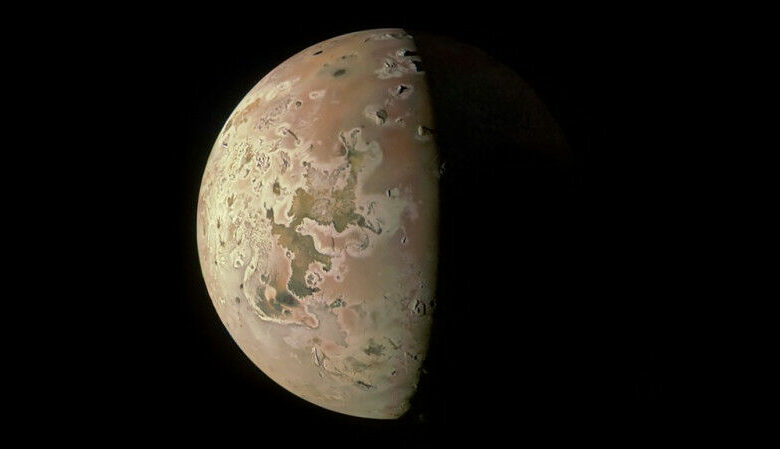NASA’s Juno to Get Related Have a look at Jupiter’s Volcanic Moon Io on Dec. 30

This symbol revealing the north polar pocket of the Jovian moon Io was once taken on October 15 by means of NASA’s Juno. 3 of the mountain peaks visuals within the higher a part of symbol, similar the day-night dividing series, have been seen right here for the primary while by means of the sp… Credit score: Symbol knowledge: NASA/JPL-Caltech/SwRI/MSSS, Symbol processing by means of Ted Stryk”
The orbiter has performed 56 flybys of Jupiter and documented close encounters with three of the gas giant’s four largest moons.
NASA’s Juno spacecraft will on Saturday, Dec. 30, make the closest flyby of Jupiter’s moon Io that any spacecraft has made in over 20 years. Coming within roughly 930 miles (1,500 kilometers) from the surface of the most volcanic world in our solar system, the pass is expected to allow Juno instruments to generate a firehose of data.
“Via combining knowledge from this flyby with our earlier observations, the Juno science group is learning how Io’s volcanoes range,” said Juno’s principal investigator, Scott Bolton of the Southwest Research Institute in San Antonio, Texas. “We’re in search of how continuously they erupt, how shining and sizzling they’re, how the atmosphere of the lava stream adjustments, and the way Io’s process is attached to the stream of charged debris in Jupiter’s magnetosphere.”
A second ultra-close flyby of Io is scheduled for Feb. 3, 2024, in which Juno will again come within about 930 miles (1,500 kilometers) of the surface.
The spacecraft has been monitoring Io’s volcanic activity from distances ranging from about 6,830 miles (11,000 kilometers) to over 62,100 miles (100,000 kilometers), and has provided the first views of the moon’s north and south poles. The spacecraft has also performed close flybys of Jupiter’s icy moons Ganymede and Europa.
This JunoCam image of Jupiter’s moon Io captures a plume of material ejected from the (unseen) volcano Prometheus. Indicated by the red arrow, the plume is just visible in the darkness below the terminator (the line dividing day and night). The image…”

“With our pair of close flybys in December and February, Juno will investigate the source of Io’s massive volcanic activity, whether a magma ocean exists underneath its crust, and the importance of tidal forces from Jupiter, which are relentlessly squeezing this tortured moon,” stated Bolton.
Now within the 3rd presen of its prolonged venture to research the foundation of Jupiter, the solar-powered spacecraft will even discover the hoop machine the place one of the crucial fuel vast’s inside moons are living.
Image This
All 3 cameras enroute Juno shall be energetic all the way through the Io flyby. The Jovian Infrared Auroral Mapper (JIRAM), which takes pictures in infrared, shall be gathering the warmth signatures emitted by means of volcanoes and calderas overlaying the moon’s floor. The venture’s Stellar Reference Unit (a navigational celebrity digicam that has additionally supplied reliable science) will download the highest-resolution symbol of the outside to week. And the JunoCam imager will pluck visible-light colour pictures.
JunoCam was once incorporated at the spacecraft for the nation’s engagement and was once designed to perform for as much as 8 flybys of Jupiter. The later flyby of Io shall be Juno’s 57th orbit round Jupiter, the place the spacecraft and cameras have persevered one of the vital photo voltaic machine’s maximum punishing radiation environments.
“The cumulative effects of all that radiation has begun to show on JunoCam over the last few orbits,” stated Ed Hirst, venture supervisor of Juno at NASA’s Jet Propulsion Laboratory in Southern California. “Pictures from the last flyby show a reduction in the imager’s dynamic range and the appearance of ’striping’ noise. Our engineering team has been working on solutions to alleviate the radiation damage and to keep the imager going.”
Extra Io, Please
Upcoming a number of months of analysis and evaluation, the Juno group adjusted the spacecraft’s deliberate while trajectory so as to add seven unutilized free Io flybys (for a complete of 18) to the prolonged venture plan. Upcoming the similar Io cross on Feb. 3, the spacecraft will fly by means of Io each alternative orbit, with each and every orbit rising steadily extra free: The primary shall be at an altitude of about 10,250 miles (16,500 kilometers) above Io, and the endmost shall be at about 71,450 miles (115,000 kilometers).
The gravitational jerk of Io on Juno all the way through the Dec. 30 flyby will let fall the spacecraft’s orbit round Jupiter from 38 days to 35 days. Juno’s orbit will loose to 33 days later the Feb. 3 flyby.
Upcoming that, Juno’s unutilized trajectory will lead to Jupiter blockading the Solar from the spacecraft for approximately 5 mins on the while when the orbiter is at its closest to the planet, a length known as perijove. Even supposing this would be the first while the solar-powered spacecraft has encountered darkness since its flyby of Earth in October 2013, the length shall be too shorten to have an effect on its total operation. Excluding the Feb. 3 perijove, the spacecraft will come across photo voltaic eclipses like this all the way through each similar flyby of Jupiter any further in the course of the remains of its prolonged venture, which results in overdue 2025.
Initiation in April 2024, the spacecraft will perform a order of occultation experiments that worth Juno’s Gravity Science experiment to probe Jupiter’s higher atmospheric make-up, which supplies key knowledge in the world’s atmosphere and inner construction.
Extra Concerning the Project
JPL, a section of Caltech in Pasadena, California, manages the Juno venture for the most important investigator, Scott J. Bolton, of the Southwest Analysis Institute in San Antonio. Juno is a part of NASA’s Untouched Frontiers Program, which is controlled at NASA’s Marshall Territory Gliding Middle in Huntsville, Alabama, for the company’s Science Project Directorate in Washington. Lockheed Martin Territory in Denver constructed and operates the spacecraft.




